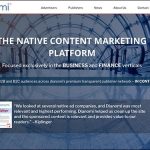How I raised $55 million without a pitch deck
Columnist Lewis Gersh says the best way for a startup to secure funding is to market a truly innovative idea. But how can you market to investors that your idea is outside the box when your pitch is squarely inside the box?

The assistant looked uncomfortable. I was there for a pitch meeting with the partner. And a pitch meeting meant a pitch deck. Didn’t it?
Not in my case.
If not a pitch deck, then what?
That awkward moment repeated when the partner and an associate entered the conference room. The associate asked about a pitch deck; I said I didn’t have one. “I always prefer to do this as a conversation,” I said.
That made the associate visibly uncomfortable.
“So, you don’t have anything to show us?” the partner said.
“I didn’t say that,” I said.
With that, I dropped a dated-looking manila envelope containing samples of our product on the conference table. “What’s in that envelope has more revenue potential than AdWords,” I said. “Let’s have a conversation about it.”
They smirked, but that didn’t bother me. I expected it. “I can walk you through a complete conversation, with a clear architecture of market and product development. Give me 22 minutes and I’ll give you the world,” I continued, paying homage to the legendary marketing line from 1010 WINS radio in New York City.
They remained skeptical. But I could also tell that they were now intrigued. Sparking intrigue should be your first goal when walking into a pitch meeting — and often a standard pitch deck proposal is anathema to that.
Why? Let me put it this way: When was the last time you said, “Oh, boy, I get to sit through a 20-minute PowerPoint presentation?”
Exactly.
Stacking the deck in your favor
My disdain for the pitch deck is based on my longtime experience on both sides of the table, and on recent trends toward more conservative investing. And it’s not an attitude that I’ve come by just recently. In the $55 million we have raised to date in three rounds of funding, I’ve never used a pitch deck to market our story to investors. And it’s a lesson that applies to B2B marketing, as well. I’ve never used a pitch deck with any of the customers we’ve met with, from small e-commerce startups to C-suite meetings at Fortune 50 companies with some of the biggest marketing budgets in the world.
I’ve never liked being on the receiving end of a pitch deck pitch, either. I saw upward of 2,000 deals a year at my fund, and the handful of pitch decks that I can even recall were wildly different from the norm — just big images that served as a backdrop while the presenter talked a good story.
Despite all of our technical sophistication, human beings remain wired for simple, compelling storytelling. That’s why I think it’s much better to have a highly structured conversation than to use a pitch deck. But to do that, you have to find the right audience — investors who are experts in the particular space for your proposed venture. That way, you can architect a storyboard to progress the conversation in an intriguing way.
Who doesn’t like a good story filled with history, characters, dominance and exploitation? OK, and maybe a dash of snarkiness doesn’t hurt. All of this has worked for Hollywood, the masters of marketing an innovative story.
Storytelling is a great way to establish rapport, which is vital. And it eliminates the need for intrusive props. If somebody already gets where you’re going but you force them to sit through a bunch of superfluous slides, that’s not respectful of their expertise.
The inverse is also true. If someone has so little expertise that they need a slideshow to pay attention and get up to speed on the space for your proposed venture, that’s not respectful of your time. A situation in harmony is an entrepreneur who has enthusiasm and a clear, well-designed story, meeting with an investor who has deep expertise in the area, and who asks good questions and offers valuable feedback.
In addition, a conversational approach allows you to maintain eye contact and pick up on body language. That’s an important chemistry test.
You’re proposing a significant level of commitment. Imagine if you went on a first date with someone and you insisted on showing them a slide show about yourself but you wouldn’t permit them to have an actual dialog. Think you’d ever hear from them again?
Are you using a pitch deck as a crutch?
Granted, to some extent your personality should determine your approach. If you lack confidence in your ability to command the room, a pitch deck is a simple way to achieve that. And, in truth, a lot of investors like the format because they’re comfortable with it. So, it’s what’s expected 99.9 percent of the time, as is the fact that a professional fund will only say yes to half a percent of all deals they see. Putting yourself in the “we are different” camp seems obvious.
With the standard meeting to market your pitch, a basic 14-slide deck will get the job done — if by “get the job done” you mean getting an audience that will respectfully sit through your presentation.
But if your job is to land a deal — and if it’s not, why are you even there? — then I don’t think a basic pitch deck will do you a lot of good.
Meanwhile, back in the conference room
When I finished my presentation with the partner and his associate, I asked a simple question: “Do you think I’m wrong, or does this have the potential for more revenue than AdWords?”
Their expressions provided the answer. The smirks had become smiles. #ditchthedeck
Opinions expressed in this article are those of the guest author and not necessarily Marketing Land. Staff authors are listed here.
Marketing Land – Internet Marketing News, Strategies & Tips
(40)














